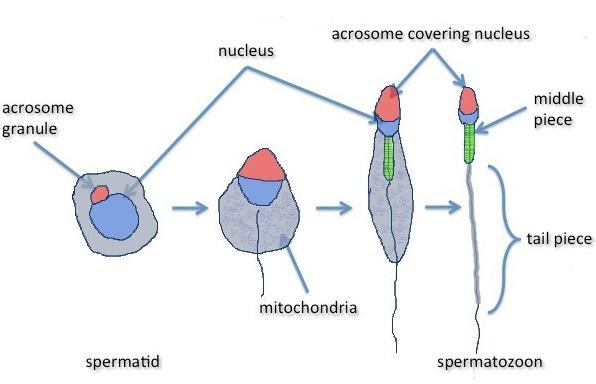
How does a spermatid differ from a spermatozoa?
Answer
368.4k+ views
Hint: Genetically, spermatid and spermatozoa are the same. But, both are different in appearance under the microscope. Spermatids are formed at the end of meiosis in testis or spermatocytes. They are haploid male gametes, which arise from the division of secondary spermatocytes. To transform into spermatozoa, spermatids must undergo a process called spermiogenesis or metamorphosis, which is the maturation of spermatids into spermatozoa.
Complete answer

Fig: Spermatid and Spermatozoon – Structural Difference
The following table differentiates spermatid from spermatozoa:
Note:
Spermatid is an immature form of the male gamete, whereas spermatozoa is a mature form of male gamete. While spermatid is found near the walls of seminiferous tubules, spermatozoa are found in the middle of seminiferous tubules. Spermatids are undifferentiated cells, but spermatozoa are differentiated cells. Spermatid is incapable of fertilizing an egg cell, whereas spermatozoa can fertilize an egg cell.
Complete answer

Fig: Spermatid and Spermatozoon – Structural Difference
The following table differentiates spermatid from spermatozoa:
| Spermatid | Spermatozoa |
| Spermatid is a rounded, large regular cell with cell organelles in it. | Spermatozoa is needle-like having three distinct parts, namely, head, tail, and middle piece. |
| Spermatids possess Golgi bodies. | Spermatozoa possess an acrosomal cap and the rest of the Golgi is discarded during metamorphosis. |
| Spermatid possesses a large and round nucleus. | The nucleus is dehydrated and oblong in spermatozoa. |
| In spermatids, centrioles are adjacent to the nucleus. | In spermatozoa, one centriole acts like a basal body, as tail filaments arise from the centriole. |
| Mitochondria are scattered in the spermatid. | A mitochondrial cloud occupies the middle piece in spermatozoa. |
| Spermatid is non-motile and haploid. | Spermatozoa can move using a flagellar tail. |
| Spermatid can’t be used as a gamete. | Spermatozoa is a functional gamete, which is used to fertilize an egg cell successfully. |
Note:
Spermatid is an immature form of the male gamete, whereas spermatozoa is a mature form of male gamete. While spermatid is found near the walls of seminiferous tubules, spermatozoa are found in the middle of seminiferous tubules. Spermatids are undifferentiated cells, but spermatozoa are differentiated cells. Spermatid is incapable of fertilizing an egg cell, whereas spermatozoa can fertilize an egg cell.
Recently Updated Pages
Using the following information to help you answer class 12 chemistry CBSE

Basicity of sulphurous acid and sulphuric acid are

Master Class 12 Economics: Engaging Questions & Answers for Success

Master Class 12 Maths: Engaging Questions & Answers for Success

Master Class 12 Biology: Engaging Questions & Answers for Success

Master Class 12 Physics: Engaging Questions & Answers for Success

Trending doubts
Which are the Top 10 Largest Countries of the World?

Draw a labelled sketch of the human eye class 12 physics CBSE

What is the Full Form of PVC, PET, HDPE, LDPE, PP and PS ?

Differentiate between homogeneous and heterogeneous class 12 chemistry CBSE

What is a transformer Explain the principle construction class 12 physics CBSE

What are the major means of transport Explain each class 12 social science CBSE




